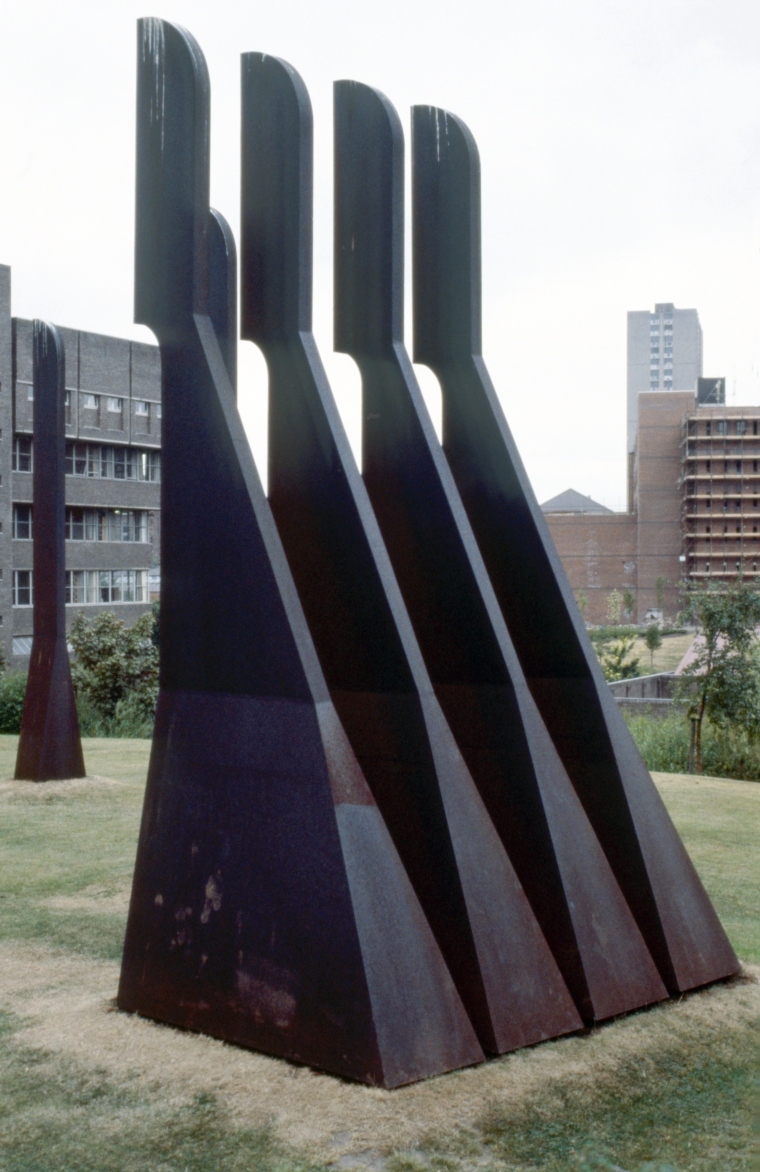Callanish (Steel Henge) 1971
Callanish (Steel Henge)
Catalogue raisonné no. 300
Artist's CR 287
1971
Kinkell
CORTEN steel on landscaped grass
192 inches / 0 cm , (each), 16 parts
-
Gerald Laing, 'Callanish', unpublished manuscript, 1971chevron_right
-
Douglas Hall, '[untitled]', unpublished manuscript, 1977chevron_right
-
An Exhibition of Sculpture by Gerald Laing at the Edinburgh Festival 1978, exhibition catalogue, Gladstone Court, 1978chevron_right
-
chevron_right
-
'Divisive Sculptor on the Trail of the Great Detective', Inverness Courier, 1990chevron_right
-
Gerald Laing: A Retrospective 1963–1993, exhibition catalogue, The Fruitmarket Gallery, 1993chevron_right
-
chevron_right
-
Gerald Laing, 'The Artist’s Eye', Art Review, Februarychevron_right
-
Gerald Laing, 'Apostasy', Northern Review, 1998chevron_right
-
Gerald Laing, 'From Here to Apostasy', Art Review, Aprilchevron_right
-
Gerald Laing: Sculpture 1968–1999, exhibition catalogue, The Fine Art Society, 1999chevron_right
-
Gerald Laing: From 1963 to the Present, exhibition catalogue, Bourne Fine Art, 2004chevron_right
-
Lindsey Ingram and Rupert Halliwell (eds.), Gerald Laing Prints and Multiples: A Catalogue Raisonné, Sims Reed Ltd, London, 2006chevron_right
-
Craig Richardson, Scottish Art Since 1960: Historical Reflections and Contemporary Overviews, Ashgate Publishing, Farnham, 2011chevron_right
-
Tam Dalyell, 'Gerald Laing: Artist whose work encompassed Sixties Pop Art and figurative sculpture', Independent, 25 Novemberchevron_right
Selected Citations and Comments
Week 38 - Callanish sculpture and landscaping project, 1974-1976 [Archives reference: OP 2/4/32, OP 2/4/35].
After 1964, the University’s estate rapidly expanded towards Cathedral Street, with the Stenhouse building, the Architecture building, the Wolfson Centre, the Strathclyde Business School (now the William Duncan building) and the Todd Centre all opening within the following fifteen years. In 1971, the University’s Planning Consultant, Mr Walter Underwood, proposed a major sculpture which would inter-relate with the complex of new buildings but remain independent of them. The Scottish Arts Council was enthusiastic about the concept and proposed to joint fund a sculpture by Gerald Laing, who they believed might produce work suited to the University and worthy of the site. Laing’s sculpture, Callanish, was erected in 1974 at the highest natural point of the campus and is based on the standing stones at Callanish in the Western Isles. In Laing’s own words it was created to “remind the scientifically orientated student that there is a place for the contemplative – and the art student that art must make use of modern scientific materials and scales to remain relevant”.
The structure, comprising sixteen steel pillars on a concrete base, is often called ‘Steelhenge’ because of its similarity to Stonehenge. The three tonnes of Cor-Ten steel used in the sculpture was chosen as it weathers naturally and changes colour slowly to form a stable rust-like appearance. The sculpture sits on an undulating lawn and is surrounded by plants, trees and an L-shaped watercourse, populated with boulders collected from the banks of the Clyde, providing an oasis for flora and fauna (springtime sees the occasional youngster with a net and bucket!).
However, the sculpture divided opinion from the outset being compared to ‘tale-ends of gondolas’ or ‘washing tongs’. A common complaint is that it has become overshadowed by the surrounding buildings and would be better suited to an open windswept ridge, like its northern namesake. Today the area provides a quiet contemplative place to visit or study; cut off from the city centre chaos outwith its boundaries.
He had an opportunity to carry out a major public work when he was commissioned by Strathclyde University and the Scottish Arts Council to create a group sculpture on a large site at the University campus in the old heart of Glasgow. Laing seized the opportunity to carry through a complex, fan shaped composition of standing forms in steel up to 14 feet high, focusing on a single form yards off. These again use the blade shape, which, without its opposing pair, takes on a sharply directional character, almost of menace. The group faces the single upright somewhat like a firing squad, and the sense of alignment also suggests the sighting of a gun. It recalls, too, recent interest in the orientation of standing stones in pre history. This great monument has been erected in its final place at Strathclyde but the landscape which should give it a proper setting has not yet been completed.
, Laing Mylius Scobie: Sculpture at Cleish, exhibition catalogue, Cleish Castle, near Kinross, 1975
In the so-called Steelhenge, the massive group of upright forms at Strathclyde University, he produced the most ambitious and impressive example of modern public sculpture in Scotland. Ambitious not only in size and scale but because it deals with the problems of sculpture at its extreme boundaries, where it reaches into matters of space and territory and orientation.
, An Exhibition of Sculpture by Gerald Laing at the Edinburgh Festival 1978, exhibition catalogue, Gladstone Court, Edinburgh, 1978, p.5
In 1970 the University of Strathclyde authorities decided that they would like to commission some pieces of outdoor sculpture for their new complex of buildings and they approached the Scottish Arts Council. Alastair Mackintosh, who was at that time working for the Arts Council, suggested that it would be a better idea to commission one major work, rather than a multiplicity of minor ones. He was aware that I had come to live in Scotland in 1969, and asked me if I could be prepared to cooperate with the coordinating architect employed by the university. At that time I was very interested in the idea of public works, especially those which could be made for specific sites. I agreed to work on the project.
My own interest at that time centred around prehistoric monoliths and stone alignments. The mute authority of these objects seems to contain the elements which are necessary in monumental outdoor sculpture - sculpture which should work whether it is glanced at by the traveller hurrying to the airport or meditated beside by the stoned mystic. I had just visited the great cruciform stone alignment at Callanish on the island of Lewis, and I suggested that one way which might contribute towards a unifying of the architectural group might be the creation of a strong axis which was independent of any individual buildings, but towards which all the buildings might relate.
There are two main open areas in the group of buildings. One is the raised courtyard at A. The other is a large grassy area at B (see plan). The original scheme, for which I made a model, was to have a main groups of monoliths in the courtyard area, and a further ‘heelstone’ consisting of two monoliths , on a grassy mound at the far end of area B. In addition, the courtyard itself was to be paved in a black and white pattern which related to the monoliths which stood on it. This would create an area of intense visual activity in the area of the courtyard, hopefully stronger than any of the buildings grouped about it. The courtyard group was aligned in area B, and consequently created an oblique axis which I hoped would act as a sort of core to the group of buildings around it.
The material chosen was cor-ten steel, because although it is a man-made material, it has almost organic characteristics as far as weathering and appearance are concerned, and from a practical point of view it is satisfactory because a) it is almost vandal-proof, having self-healing properties; b) it requires no maintenance, and c) it doesn’t look tacky as it ages, unlike painted steel or plastic as most of the other materials that are practicable for this type of application. The total number of monoliths is 16, and they are all 16 feet high. There are three types, which are developed from three basic forms which I was using in 1970, and which have the generic names of Pyramids, Pins and Knives.
The model was submitted to the university council for consideration. Apparently it caused complete division of opinion then, some members being in its favour, and some almost violently against. Violent reaction to works of art is basically a reassuring phenomenon; indifference is, after all, the most dangerous enemy. The cultural imperialism of the USA and the repression of art and liberation in the USSR reminds us, if we need reminding, of the powerful nature of our work.
After a lot of discussion, and thanks largely to the efforts of Douglas Hall of the Scottish National Gallery of Modern Art, Alastair Mackintosh, and Professor Fletcher of the UMS, the scheme was finally accepted, but with the modification that the whole group was to be sited on the grassy area. From the point of view of the sculpture itself this was obviously better - it could now be seen as a separate and independent entity, more or less detached from the buildings. But the implications of this is, of course, that it would be preferable to take it away from the urban environment altogether. Like its namesake on the Island of Lewis, it would be at its most powerful sited on a lonely promontory jutting into the sea. Since it is besides a group of buildings in the middle of Glasgow, it is captured, appropriated, and become a badge. And there’s the rub., 'Callanish', unpublished manuscript, 1971

__50h.jpg)
_cropped_rgb__50h.jpg)

__large.jpg)
_cropped_rgb__large.jpg)
